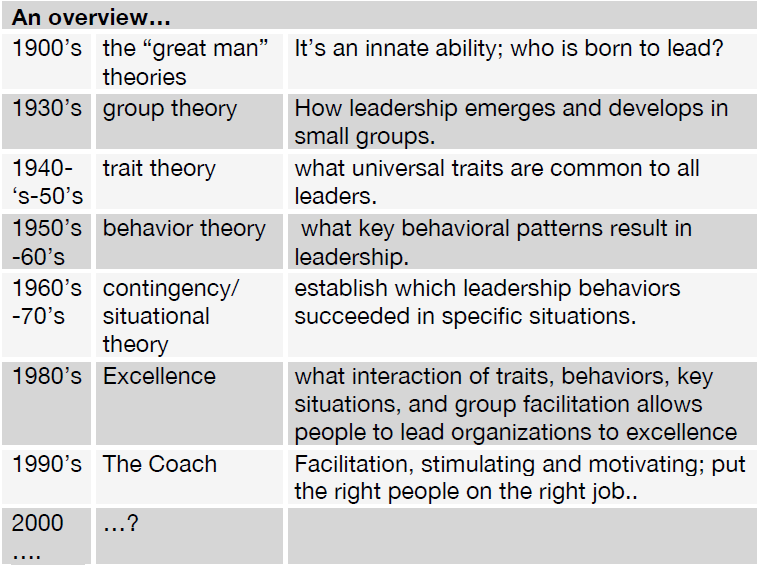The central question of this paper will be:
What are the new needed leadership skills and in what way can coaching skills contribute?
Leadership Theories: A 20th Century History
(Source: http://www.managementsite.nl/4459/leiderschap/ontwikkeling-leiderschap.html)
On the one hand the role of leaders could be seen as facilitating relations within a group; on the other hand as to take care of a good execution of tasks. In other words you could speak of task- or relationship oriented leadership till the 90’s. The generation X demanded however another style. They asked for a more coaching style. The manager had to facilitate, stimulate and motivate them. But still this was more or less a top down approach: how to put the right men on the right job or how to match the given capacity with the goals of the organization. Maybe we can see this as the first stage of coaching….
At least it led to a new insight; to think and act really from the employee, to let them grow and to inspire them. Leadership is now more based on a spiritual quality; the power to inspire others to follow (Vince Lombbardi).
The competences of inspirational leadership
In summary we see the following shifts in leadership:

We see the role of a leader itself has changed overtime. The prospective leader needs to align people, to engage, to be open for ideas of the team…They need to inspire.
2 Systems thinking is a way of understanding reality that emphasizes the relationships among a system’s parts, rather than the parts themselves.
The ability to inspire people to reach great heights of performance and success is a skill that leaders need nowadays. Passion, purpose, listening and meaning help make a leader inspirational. The ability to communicate that passion, purpose and meaning to others helps establish the inspirational culture of an organization.
What does this mean?
- The inspirational leader feels passionately about the vision and mission of the organization. He or she is also able to share that passion in a way that enables others to feel passionate, too. The nature of the vision and mission is critical for enabling others to feel as if their work has purpose and meaning beyond the tasks they perform each day. Sometimes leaders have to help their staff connect the dots by explaining this big picture to all. Communicating the big picture regularly will help reinforce the reason your organization exists.
- The inspirational leader also listens to the people in her organization. Talking to people about your passion is not enough. You must allow the ideas and thoughts of your staff to help form the vision and mission, or minimally, the goals and action plan. No one is ever one hundred percent supportive of a direction they had no part in formulating. People need to see their ideas incorporated – or understand why they were not. Let’s call it participation.
- To experience inspiration, people also need to feel included. Inclusion goes further than the listening and feedback; for real inclusion, people need to feel intimately connected to the actions and process that are leading to the accomplishment of the goals or the decision. The inclusion led to a compromise that, while not perfect, still enables a celebration and a positive motivation boost, and allows the company to meet customer needs.
- Important to inspiration is the integrity of the person leading. Yes, vision and passion are important, but employees must trust the leader to feel inspired. They must believe in you. Your “person” is as important as the direction you provide. Employees look up to a person who tells the truth, tries to do the right things, lives a “good” life and does their best. Therefore you need to live your values.
- A great leader also provides opportunities for people to grow, both personally and professionally. This means you need to have the belief that if you invest in your employees to let them grow, you can trust that they will give you what you have in mind. The advantage of this approach is that it will come from inside out. You can compare this with the “Semco” approach.
- The inspirational leader also understands that, while money is a motivator, so are praise, recognition, rewards, a thank you and noticing an individual’s contribution to a successful endeavor. An inspirational leader needs the ability to acknowledge his or her employees.
- Finally and maybe the most crucial and most difficult one is to be authentic. Robert Goffee and Gareth Jones are talking about the four unexpected qualities:
- Inspirational leaders selectively show their weakness.
- They rely heavily on intuition to gauge the appropriate
- timing and course of their action.
- They manage employees with something we call empathy.
- They reveal their differences.
